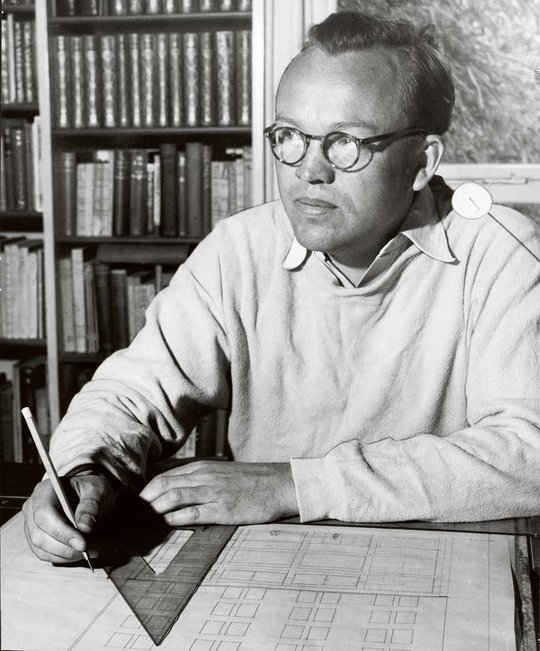| | | | Newsletter 1/8
The 1930s: The Education, the Steady Paycheck and the Design Experiments |
| | |
| |
|
| | | | After the summer break, we are releasing a serialized newsletter. In eight parts we will share the story of Finn Juhl throughout the decades, from the very beginning to the international fame, the iconic furniture and later the subsiding interest. Last but not least, we will talk about today as Finn Juhl once again stands out as one of the designers who was furthest ahead of his time. In this newsletter, we focus on the beginning of Finn Juhl's career in the 1930s. |
| | |
| |
|
| | | |  | Finn Juhl was born in Frederiksberg in Copenhagen on January 30th, 1912. His father, Johannes Juhl, was a merchant in the textile industry. His mother, whose maiden name was Emmy Goecker, passed away just three days after giving birth. In addition, Finn had a brother who was two years older than him. Photo: The Royal Danish Library, Pressehuset. |
| | |
| |
|
| | | | 1930 Finn Juhl graduates from Skt. Jørgen's High School and is admitted to the School of Architecture, which is a part of the Royal Danish Academy of Fine Arts. In reality he dreams about studying art history, but his father will not allow it. Therefore, Finn Juhl studies to become an architect under professor Kaj Fisker. Despite this, art remains a continuing source of inspiration for Finn Juhl throughout his life. As an eighteen year old Finn Juhl visits the Stockholm Exhibition per Kaj Fisker's suggestion. Here, his eyes are opened to Erik Gunnar Asplund's functionalistic buildings, that serve as the first signal that modernism has truly reached Scandinavia. At the exhibition he experiences the contemporary stylistic trends and the struggle between the old versus the new as expressed via architecture. The exhibition, the breakthrough of functionalism and his interest in modern art all help to shape Finn Juhl's style, both as an architect and as a designer. |
| | |
| |
|
| | | | 1934 Finn Juhl is hired at the prominent architecture firm run by Vilhelm Lauritzen, who also lectures at the academy, where Finn Juhl is enrolled. During his employment, the firm designs Copenhagen Airport and the new national broadcasting building - Radiohuset. In close cooperation with the architect Viggo Boesen, Finn Juhl is tasked with designing the interior of the building. Today Radiohuset still stands as an exemplary work of functionalism. As time passes, work takes up all of Finn Juhl's time and he ends up not completing his studies. Finn Juhl works for Vilhelm Lauritzen Architects until 1945, where he establishes his own design studio. |
| |  | The interior of the broadcasting building (Radiohuset). Vilhelm Lauritzen Architects. |
|
| | |
| |
|
| | | |  | The Facade of the broadcasting building (Radiohuset). Vilhelm Lauritzen Architects. |
| | |
| |
|
| | | | 1937 Finn Juhl debuts at the Cabinetmakers' Guild Exhibition in collaboration with master joiner Niels Vodder. This marks the beginning of a long and fruitful partnership between the two. The Cabinetmakers' Guild Exhibition in Copenhagen is a vital opportunity for young designers to showcase themselves and their designs. Here, they attempt to rejuvenate the proud Danish design tradition and introduce a more modern expression. His contemporary design colleagues, Børge Mogensen and Hans J. Wegner, also partake in the exhibition. Furthermore, Finn Juhl marries the dentist Inge-Marie Skaarup on July 15th. |
| | |
| |
|
| | | | 1938 Finn Juhl displays the Grasshopper Chair at his stand during the Cabinetmakers' Guild Exhibition. Though, the animal-like chair attracts plenty of attention, the visitors at the exhibition find the chair too radical. Finn Juhl ends up purchasing both samples for himself, such that Niels Vodder does not suffer greater loss than necessary. Due to the lack of commercial interest, the chair is not put into production. 80 years later, in 2018, one of the two original Grasshoppers is sold at the Art Curial auction in Paris for the price of EUR 319,000 (DKK 2.4 million). |
| | |
| |
|
| | | |  | Finn Juhl in the Grasshopper Chair, launched in 1938. |
| | |
| |
|
| | | |  | The Grasshopper Chair in walnut, relaunched in 2019. |
| | |
| |
|
| | | | In the next newsletter of this series, you will be able to explore Finn Juhl's rise to fame throughout the 1940s. Warmest summer greetings, House of Finn Juhl
|
| | |
| |
|
| | | | House of Finn Juhl is part of Onecollection A/S Vesterled 19 - DK-6950 Ringkøbing - T +45 70 277 101 www.finnjuhl.com |
| | |
| |
|
|